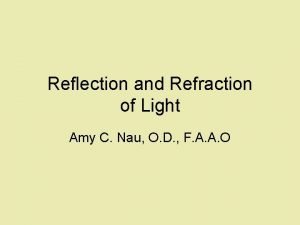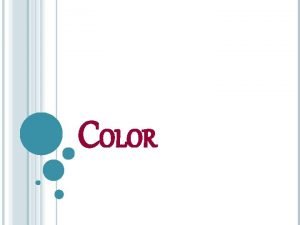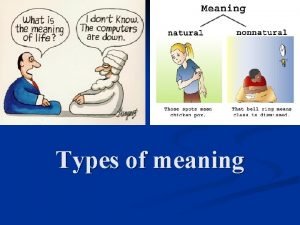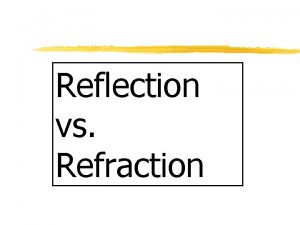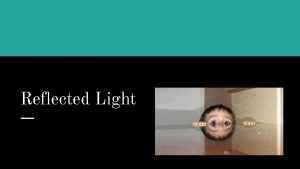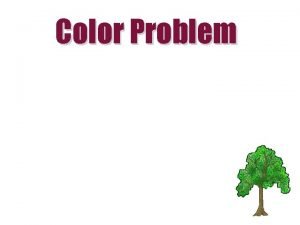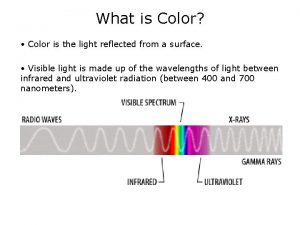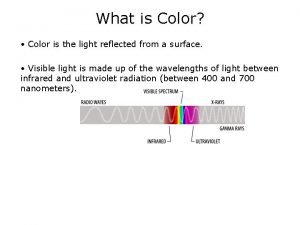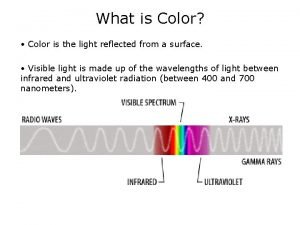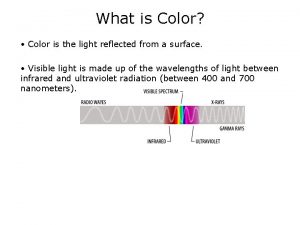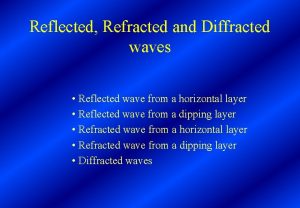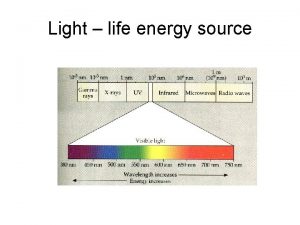What is Color Color is the light reflected












- Slides: 12

What is Color? • Color is the light reflected from a surface. • Visible light is made up of the wavelengths of light between infrared and ultraviolet radiation (between 400 and 700 nanometers).

Color Models Additive Model Subtractitive Model RGB, Light CMYK, Pigment

Additive Color Sergei Mikhailovich Prokudin-Gorskii. Dmitrievskii Church, 1911.

Describing Color Hue The ‘color’ of the color. Red, Orange, Yellow, Green, Blue, Indigo, Violet Value Lightness (tint) or darkness (shade) of a color. Saturation (Chroma) Intensity of the hue in the color. Desaturated colors tend to look gray.

Color Contrast Low Contrast Of Hue Contrast Of Value Contrast Of Saturation High Contrast

Newton’s Color Model A color circle, based on red, yellow and blue, is traditional in the field of art. Sir Isaac Newton developed the first circular diagram of colors in 1666. Graphics taken from www. colormatters. com

Primary Colors Primary colors are the most basic colors; they cannot be broken down into component colors. The primary colors are different depending on which color model you are using. The primary colors in the Newtonian color model are red, yellow, and blue. Graphics taken from www. colormatters. com

Secondary Colors These are the colors formed by mixing the primary colors. Graphics taken from www. colormatters. com

Tertiary Colors These are the colors formed by mixing one primary and one secondary color. Graphics taken from www. colormatters. com

Color Relationships Primary Colors Secondary Colors Essential colors, cannot be broken down into component colors Mixture of two primary colors Analogous Colors located close together on a color wheel. Complementary Colors Located opposite each other on a color wheel Newtonian (Artist’s) Color Wheel Monochromatic Colors Shades and tints of the same color Shade and Tint Intensity Add black or white Amount of saturation) Graphics taken from www. worqx. com/color

Color Temperature can be measured absolutely, or relatively. For example, yellow-green is warmer than cyan-green, but both are cool colors. An approximate separation of absolute color temperature is denoted below: M R A W L O O C Nearly any color could appear as either warm or cold depending on the surrounding colors, especially those near the dividing line.

Color Context Red appears more brilliant against a black background and somewhat duller against the white background. In contrast with orange, the red appears lifeless; in contrast with blue-green, it exhibits brilliance. Notice that the red square appears larger on black than on other background colors. Graphics taken from www. colormatters. com
 The amount of light that is reflected depends on: *
The amount of light that is reflected depends on: * Colorter
Colorter What are the 6 elements of art
What are the 6 elements of art Light light light chapter 23
Light light light chapter 23 Light light light chapter 22
Light light light chapter 22 Chapter 22
Chapter 22 Reflected appraisal
Reflected appraisal Seven types of meaning by geoffrey leech
Seven types of meaning by geoffrey leech Reflected radiation formula
Reflected radiation formula Compositional meaning
Compositional meaning Refraction vs reflection
Refraction vs reflection Reflected appraisal
Reflected appraisal Reflected appraisal
Reflected appraisal
